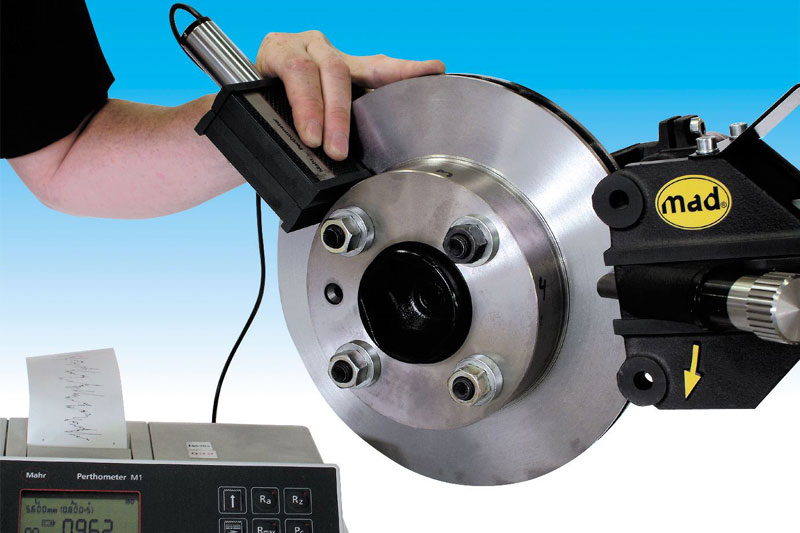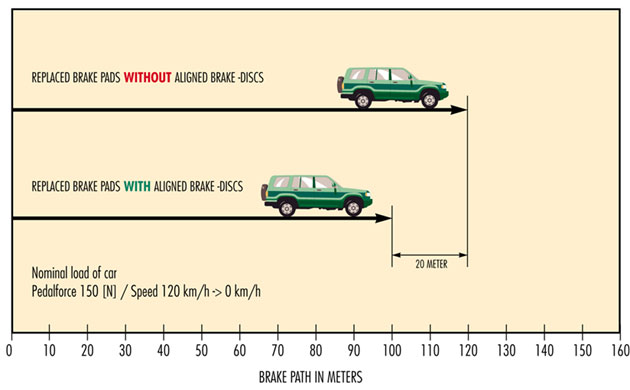
Brake disc lathes fix brake noise, remove corrosion, eliminate vibration issues, save waste and are very green. On top of this, they offer value for money and make can return decent amounts of profit.
Currently, around 5% of UK workshops have brake a disc lathe meaning there are 95% of workshops who are still to learn the benefits. Here, Dynastat dispels some of the myths surrounding brake disc replacement and offers some best practise advice.
Myth 1: Machining discs is unprofitable
Labour in the garage doesn’t have to be delivered from your parts supplier. You just have to make it a line item on the invoice. Good machines can machine the disc in less than 10 minutes, so charge £30 per axle and that equates to £90 per hour.
Brake Disc Replacement
Installing new brake discs does not eliminate the possibility of a comeback. This myth creates more comebacks than it solves. These comebacks often start with blaming the new pads, and ends with the customer having to return a second or third time.
Installing new brake discs is not a way to avoid having to use a micrometer or dial indicator. For every brake job, always measure for runout (disc and flange) and the dimensions of the disc replacement before brake service is performed.
After the disc is resurfaced or a new disc is installed, the disc should be measured for runout when it is installed on the vehicle as a quality control method. A disc replacement could have excessive runout when it is installed on the vehicle due to a stacking of tolerances.

Myth 2: New discs prevent comebacks and are cheaper and more profitable than an on-the-car lathe
What if the runout exceeds the manufacturer’s specifications when the new disc is installed on the vehicle? It has often been said that you should never machine new discs, but in some cases, a new disc should be machined to match the vehicle with an on-the-car brake lathe.
Twenty two Vehicle Manufacturers have made an on-car brake lathe either mandatory or highly recommended, including Mercedes Benz, BMW and Porsche.
Installing new Discs
Using an on-the-car lathe can help to reduce runout on new discs. The main advantage of these lathes is that they are able to cut a disc in its operating plane. This means that the disc is machined to match the hub.
Myth 3: Rotors do not need to be measured
Even if new discs are used, the chance of a pulsation comeback could be greater than if the old discs are left on the vehicle. Runout in the hub and new disc can stack up to cause Disc Thickness Variation (DTV) in a few thousand miles. DTV is the main cause of pulsation.
Runout greater than 0.05mm is a sign that the flange, disc and/or bearing should be replaced if you do not own an on-car lathe. The needle of the dial indicator should be perpendicular to the rotor. Measurements should be taken 10mm from the edge.
Myth 4: Two passes make for a better finish
Cutting a disc in one pass is essential for productivity. For non-composite rotors, it is possible to take as much as 0.5mm per side while still having an acceptable finish. However, with a composite rotor or one with hard spots, the depth should be reduced, likely below 0.025mm per side, for a quality finish. In order to remove this much material, it is essential to have sharp bits.
Cutting too fast will reduce the cut quality and possibly create chatter. A larger diameter rotor will need to turn slower than a small diameter one and some machines do not have variable speeds (avoid).
Poor disc finish can lead to noise. The two primary goals of machining a disc are to provide a smooth surface finish for the pads, and provide a true surface finish.









